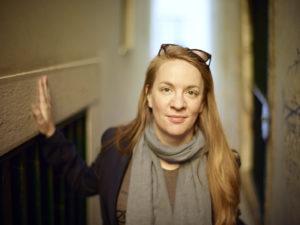What does Shakespeare have to do with clickbait? How much in common did ancient indigenous peoples have with the Twitter community? Was Dante’s “Inferno” the original “explainer” story?

Amy O'Leary
The surprising answers, according to Upworthy’s Amy O’Leary, are “plenty,” “a lot,” and “but of course.” O’Leary, Upworthy’s editorial director, presented a lively session at this year’s Power of Narrative conference, making the unlikely connection, as she put it in the title of her talk, from “Scheherazade to Snapchat.”
Upworthy might look like it represents the baser instincts of internet journalism, with its unwavering focus on virality: video memes, listicles, and those “explainer” articles that often feature headlines beginning with “How” or “Why.” (“How SeaWorld’s empire collapsed: a tragedy in 3 acts.”) But O’Leary was an expert defender of her business, deftly explaining the hows and whys of stories that stick, and demonstrating the ways these “new” journalism models are in fact examples of centuries-old storytelling methods that have always been a critical component of human interaction.
O’Leary has become a fixture at the annual Power of Narrative conference, hosted by Boston University’s College of Communications. In part that’s because she bridges traditional journalism with the field’s digital-era incarnation. (Before arriving at Upworthy, she worked for “This American Life” and The New York Times.) But while thoroughly committed to the art of journalistic narrative, she has a healthy skepticism for some of its ingrained principles. Here are four longstanding techniques she’s adapting to journalism:
- Be funny. It’s OK to inject a little humor into your work, she told her attentive audience. Shakespeare did; he toggled effortlessly between highbrow cultural references and dick jokes.
- Welcome the chorus. “Our stories are better when we recognize that as a group we are stronger than one individual,” she said. The Laguna Pueblo people passed down instructive tales by collective memory and invited “crowd-sourced” amendments, and today’s social media users can band together to gain control of a narrative. O’Leary cited #BlackLivesMatter on Twitter as a prime example, where users successfully affected public perception of a series of tragic events, spurring acknowledgement of the need for police reform.
- Moralize. It’s an admirable goal to include some morality in your reporting, she argued. If a story seems destined to elicit a clear-cut reaction in readers – she cited the case of the Muslim student who was arrested for bringing a homemade clock to school for a science project, which attracted a deluge of outrage – why not say so? Increasingly, readers find it disingenuous not to.
- Cultivate empathy. O’Leary summoned the legacy of Joseph Campbell, who believed that the modern era suffers from waning familiarity with “the literature of the spirit.” Instead, we’re preoccupied with the news of the day, the problems of the hour. “Our stories should make the world a better place,” she said.
These are all founding precepts of Upworthy. The site was established with an unapologetically progressive mission, deliberately not professing traditional media “neutrality.” How has that worked? Upworthy has been called “the fastest-growing media site of all time.” That certainly suggests a large number of readers are open to receiving news with a measure of perspective.
In an age of countless distractions, journalists must learn not only how to attract and engage readers, but to retain them. For this, O’Leary cited “This American Life’s” Ira Glass for teaching her to to routinely revisit the premise of the classic Middle Eastern folk tale “One Thousand and One Nights.” Just as Scheherazade preserves her own life by telling the murderous king a little more of her story each night – the ancient version of the cliffhanger – writers should always leave their readers wanting more. Holding the reader’s interest is “life and death for our industry,” she said, just as it was for Scheherazade.
“There is no greater drive in the human mind than to resolve the question, ‘What happens next?’” she said.


